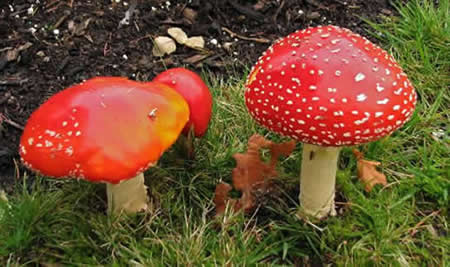K-12 Activities
For Self-learners

K-12 Activities
For Self-learners
THE FUNGI KINGDOM

Fly amanita (Amanita muscaria), photo by Rosemary Taylor.
ACTIVITY: THE MACROFUNGI OF BRITISH COLUMBIA
In this activity, we explore the macrofungi of British Columbia via E-Flora BC. Macrofungi are the fleshy fungi and include mushrooms or ''toadstools', puffballs, hoofed fungi, coral fungi and other large types of fungi. E-Flora BC provides atlas pages on each species found in BC. Each atlas page contains important biogeographic information. This includes information on the geography of a species, the substrate it grows on, what it looks like, and how to identify it by colour, smell and microscopic features.
Links to BC Curriculum: Prescribed Learning Outcome: Time Frame: |
Preparation (instructions for teachers)
Collect a mixture of macrofungi in the fall and bring to the classroom. Include examples of different macrofungi types, including gilled fungi, pore fungi, jelly fungi, puffballs, and coral fungi. Some mushrooms are poisonous, so be careful when handling them—wash your hands after handling. Display in a transparent container is recommended.
Familiarize yourself with the contents and resources of the E-Flora website. This site covers vascular plants, (macro)fungi, algae, bryophytes, lichens and slime molds.
Become particularly familiar with the fungi sections and the basics of fungal diversity, habitats, and structure. This information can be obtained from the E-Flora species pages. Read the introduction to the fungi on E-Flora BC: The Macrofungi of British Columbia. Visit a selection of atlas pages.
Key points:
Methods:
15 minutes – Diversity of BC fungi
Gather students around the collection of wild fungi. Discuss several specimens and ask questions to engage students, such as:
(This portion of the lesson is an opportunity to assess students’ background knowledge and incite their curiosity.
15-20 minutes – Ecology of fungi
Allow students to think about the roles that fungi play in the different ecosystems where they occur, and how they relate to other species. Guide the discussion with questions like:
15 minutes – The fungi around us
Assessment:
1) What are the main morphological characteristics of mushrooms? Draw a gilled mushroom and label cap, gills, spores and stipe.
2) How do fungi reproduce?
3) What is the ecological importance of fungi.
4) Where do fungi grow and where can they be found in BC?
Field Trip Activity (30-40 minutes):
Plan a field trip with your class to the school backyard (if fungi can be found there) or the forest, if possible. The best time of the year to do this would be the fall, when mushrooms are abundant. Prepare students for the field trip by browsing E-Flora BC for the types of mushrooms they will be looking for in the wild (e.g., puffballs, jelly fungi, gilled mushrooms’, ear fungi, hoof fungi). The discussion could be directed by questions such as:
IMPORTANT NOTE
This is not a specimen collection activity, but an observation one Because so many mushrooms can be difficult to identify correctly, and because there are many poisonous species, you should never eat a wild mushroom. Mushrooms should be identified by experts who are familiar with similar-looking species and can separate poisonous ones from edible ones. Eating wild mushrooms is not for beginners.
Page prepared by Adriana Briseno-Garzon, 2013